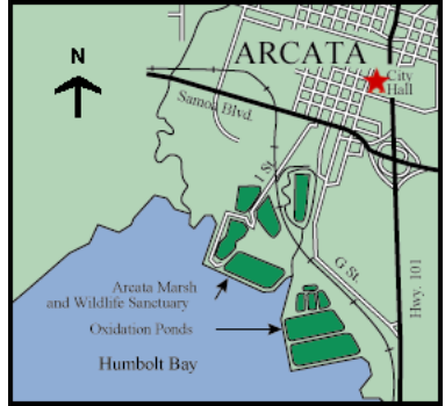1981: Restoration and Wastewater Treatment Plan

Figure 5: Location of Arcata Marsh and Wildlife Sanctuary and original oxidation ponds [5].
A marsh restoration and wastewater treatment plan was proposed as a result of the integration of several other projects. From 1979 to 1982 the City and associated proponents of the proposed alternative wastewater treatment, experimented with partially treated wastewater and the processes of the wetland system. The Arcata Marsh and Wildlife Sanctuary was dedicated on July 4, 1981. The constructed wetlands could be used to treat wastewater and enhance biological productivity of the wetlands into which the treated wastewater was discharged [6,7].
The California Coastal Conservancy Agency was recruited by the city of Arcata to support the new plan to enhance the “receiving water” [6]. This conservancy assisted in the funding of the restoration practices associated with the site. The City of Arcata viewed the wastewater as a “resource” that could be reused, not just disposed. The city Task Force on Wastewater Treatment recognized that a constructed wetland could cost effectively and efficiently become a wastewater treatment system [7]. In 1983 the city was authorized, after the hard work of the Arcata City Council and representatives in the state capital, to construct the proposed wetland system and incorporate the original Arcata Wastewater Treatment Plant. By 1986 the wetland that exists today was completed [6,7].
The California Coastal Conservancy Agency was recruited by the city of Arcata to support the new plan to enhance the “receiving water” [6]. This conservancy assisted in the funding of the restoration practices associated with the site. The City of Arcata viewed the wastewater as a “resource” that could be reused, not just disposed. The city Task Force on Wastewater Treatment recognized that a constructed wetland could cost effectively and efficiently become a wastewater treatment system [7]. In 1983 the city was authorized, after the hard work of the Arcata City Council and representatives in the state capital, to construct the proposed wetland system and incorporate the original Arcata Wastewater Treatment Plant. By 1986 the wetland that exists today was completed [6,7].
